MITSUBISHI LANCER 2016 8.G Service Manual
Manufacturer: MITSUBISHI, Model Year: 2016, Model line: LANCER, Model: MITSUBISHI LANCER 2016 8.GPages: 392, PDF Size: 13.12 MB
Page 41 of 392
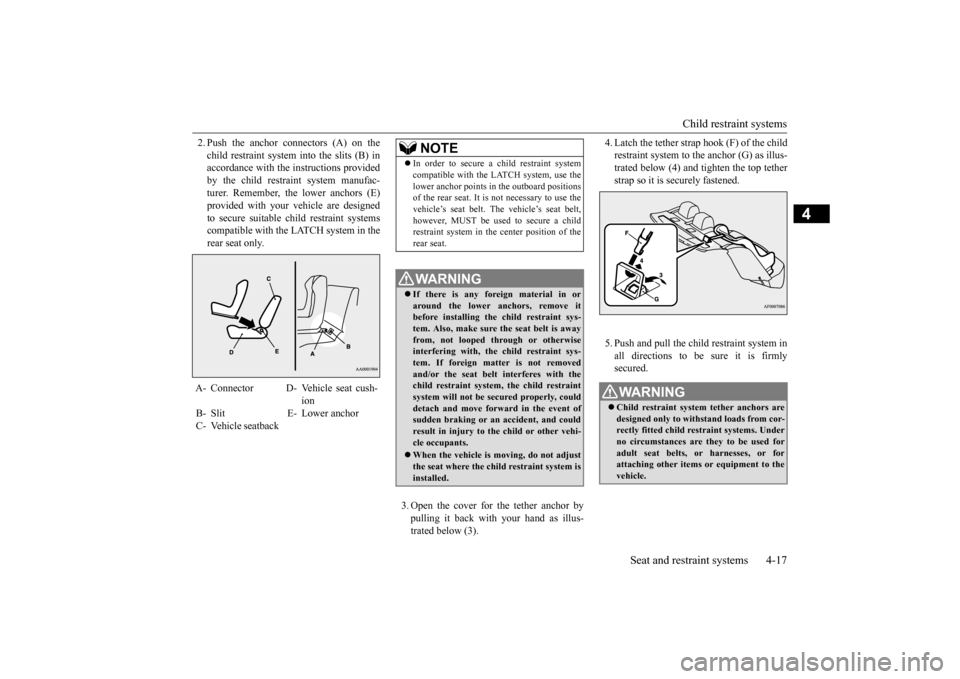
Child restraint systems
Seat and restraint systems
4-17
4
2.Push
the
anchor
connectors
(A)
on
the
child
restraint
system
into
the
slits
(B)
in
accordance
with
the
instructions
provided
by
the
child
restraint
system
manufac-
turer
. Remembe
r, the
lower
anchors
(E)
provided
with
your
vehicle
are
designed
to
secure
suitable
child
restraint
systems
compatible
with
the
LA
TCH
system
in the
rear seat onl
y.
3.Open
the
cover
for
the
tether
anchor
by
pulling
it back
with
your
hand
as
illus-
trated below
(3).
4.Latch
the
tether
strap
hook
(F)
of the
child
restraint
system
to the
anchor
(G)
as illus-
trated
below
(4)
and
tighten
the
top
tether
strap so it is securely fastened.5.Push
and
pull
the
child
res
traint
system
in
all
directions
to
be
sure
it
is
firmly
secured.
A-
Connector
D-
Vehicle
seat
cush-
ion
B-
Slit
E-
Lower anchor
C-
Vehicle
seatback
NOTE
In
orde
r to secure
a child restrain
t system
compatib
le with the LATCH
system,
use
the
low
er anchor
points
in the
outboard
pos
itions
of the rear seat.
It is not
necessa
ry to use
the
vehicle’
s seat
belt.
The
vehicle’
s seat
belt,
howe
ver, MUST
be use
d to secure
a child
restraint
system
in the
center
position
of the
rear
seat.
W
AR
NING
If
the
re is any
for
eign
materia
l in or
around
the
lower
anc
hor
s,
remove
it
befor
e installing
the
child restraint
sys-
tem. Also, make
sure the
seat
belt
is away
from,
not
looped
thr
ough
or
otherwise
interfering
with,
the
child
restraint
sys-
tem.
If
for
eign
matter
is
not
removed
and/
or the
seat
belt interf
eres with
the
child restrain
t system,
the child restrain
t
system
will not be secu
red properly
, cou
ld
detach
and
move
forw
ard
in the even
t of
sudden
braking
or
an
accident,
and
could
resul
t in injury
to the
child or other
veh
i-
cle
occupa
nts.
Whe
n the
vehicle
is movi
ng, do
not
adjust
the
seat
whe
re the
child restraint syste
m is
installed
.
W
AR
NING
Child
restraint
system tether
anc
hor
s are
designed
only
to withstand
loads
from
cor
-
rectly fitted
child restrain
t systems
. Unde
r
no circumstan
ces
are they
to be use
d for
adul
t seat
belts,
or har
nesses,
or for
attac
hing
other
items
or equi
pme
nt to the
vehicle.
Page 42 of 392
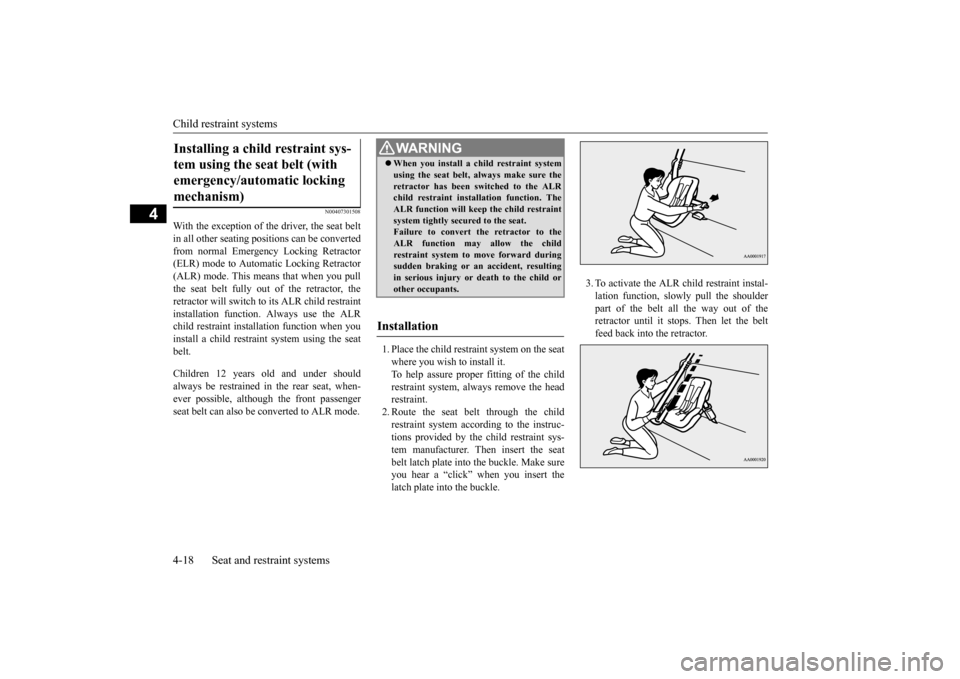
Child
restraint
systems
4-18
Seat and restraint systems
4
N0040730
1508
With
the
exception
of
the
driver
, the
seat
belt
in all other
seating
positions
can
be
converted
from
normal
Eme
rgency
Locking
Retractor
(ELR)
mode
to Automatic
Locking
Retractor
(ALR)
mode.
This
means
that
when
you
pull
the
seat
belt
fully
out
of
the
retractor
, the
retractor
will
switch
to its
ALR
child
restraint
installation
function.
Always
use
the
ALR
child
restraint
installation
function
when
you
install
a child
restraint
system
using
the
seat
bel
t.
Children
12
years
old
and
under
should
always
be
restrained
in
the
rear
seat,
when-
ever
possible,
although
the
front
passenger
seat belt can also be converted to ALR mode.
1.Place
the
child
restraint
system
on
the
seat
where you wish to install it.To help
assure
proper
fitting
of
the
child
restraint
system,
always
remove
the
head
restraint.2.Route
the
seat
belt
through
the
child
restraint
system
according
to
the
instruc-
tions
provided
by
the
child
restraint
sys-
tem
manufacturer
. Then
insert
the
seat
belt
latch
plate
into
the
buckle.
Make
sure
you
hear
a “click”
when
you
insert
the
latch plate into the buckle.
3.To activate
the
ALR
child
restraint
instal-
lation
function,
slow
ly
pull
the
shoulder
part
of
the
belt
all
the
way
out
of
the
retractor
until
it stops.
Then
let
the
belt
feed back into the retractor
.
Installing a child r
estraint sys-
tem using the seat belt (with emergency/automatic locking mechanism)
W
AR
NING
Whe
n you
install
a child restraint
syste
m
usi
ng
the
seat belt,
always
make
sur
e the
retractor
has
been
swi
tched to
the
ALR
child restraint
installati
on
func
tion.
The
ALR
func
tion
will keep
the
child restraint
system
tightly
secur
ed to the
seat.
Failur
e to
convert
the
retractor
to
the
ALR func
tion
may allow
the
child
restraint
system to move
for
war
d durin
g
sudden
braking
or
an
accident,
resulting
in serious
injury
or
death
to the
child
or
other
occupa
nts.
Installation
Page 43 of 392

Child restraint systems
Seat and restraint systems
4-19
4
4.After
the
belt
has
retracted,
tug
on
it.
If
the
belt
is in
the
ALR
function,
you
will
not
be
able
to
pull
it out.
If the
webbing
can
be
pulled
out
from
retracto
r, the
ALR
function
has
not
been
activated
and
you
will need to repeat steps 3 and 4.5.After
confirming
that
the
belt
is locked,
grab
the
shoulder
part
of
the
belt
near
the
buckle
and
pull
up
to
remove
any
slack
from
the
lap
part
of
the
belt
allowing
the
slack
to feed
into
the
retractor
. Remember
,
if the
lap
belt
portion
is not
tight,
the
child
restraint
system
will
not
be
secure.
It may
help
to
put
your
weight
on
the
child
restraint
system
and/or
push
on
its
seat-
back
while
pulling
up
on
the
belt
(see
illustration).
6.Open
the
cover
from
the
tether
anchor
installation
point
by
pulling
it back
with
your hand as illustrated below (6).7.Latch
the
tether
strap
hook
(A)
of
the
child
restraint
system
to the
tether
anchor
(B)
as illustrated
below
(7)
and
tighten
the
top tether strap so it is securely fastened.
8.Before
putting
your
child
in the
restraint,
push
and
pull
the
restraint
in all directions
to
be
sure
it is
firmly
secured.
Do
this
before
each
use.
If the
child
restraint
sys-
tem
is
not
firmly
secure,
repeat
steps
1
through 7.9.To remove
a child
restraint
system
from
the
vehicle
and
deactivate
the
ALR
mode,
remove
the
child
from
the
restraint.
Unlatch
the
buckle.
Then
remove
the
belt
from
the
restraint
and
let
the
belt
fully
retract.
10.
Reinstall the head restraint.Refer to “Head restraints” on page 4-6.
N00407601
644
Children
who
have
outgrown
a child
restraint
system
should
be
seated
in
the
rear
seat
and
wear
the
seat
belt.
If the
shoulder
belt
crosses
their
face
or
neck,
and/or
the
lap
belt
crosses
their
stomach,
a
commercially
available
booster
seat
must
be
used,
to raise
the
child
so
that
the
shoulder
belt
crosses
their
shoulder
and
the
lap
belt
remains
positioned
low
across
their
hips.
The
booster
seat
should
fit
the
vehicle
seat
and
have
a label
certifying
compliance
with
Federal
Motor
Vehicle
Safety
Standards
or
Motor
Vehicle
Restraint
If your
child
restraint
system
requires
the
use
of
a tether
strap,
fasten
the
tether
strap
in
accordance with the following procedures.
W
AR
NING
Child
restraint
syste
m tether
anc
hors
are
designed
only
to withstand
loads
from
cor
-
rectly fitted child r
estraint systems. Under
no circumsta
nces
are the
y to be use
d for
adul
t seat
belts,
or
har
nesses,
or for
attach
ing
other
items
or
equi
pme
nt to the
vehicle.
Childr
en who have outg
rown
child r
estraint systems
Page 44 of 392
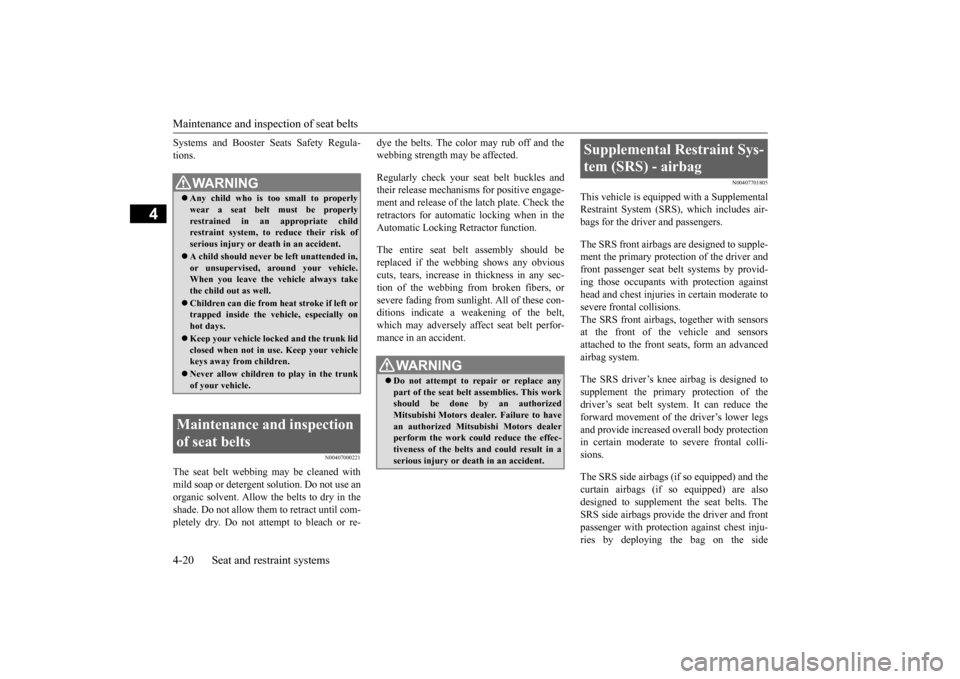
Maintenance and inspection of seat belts4-20
Seat and restraint systems
4
Systems
and
Booster
Seats
Safety
Regula-
tions.
N0040700
0221
The
seat
belt
webbing
may
be
cleaned
with
mild
soap
or deter
gent
solution.
Do
not
use
an
organic
solvent.
Allow
the
belts
to dry
in the
shade.
Do
not
allow
them
to retract
until
com-
pletely
dry
. Do
not
attempt
to
bleach
or
re-
dye
the
belts.
The
color
may
rub
off and
the
webbing strength may be a
ffected.
Regularly
check
your
seat
belt
buckles
and
their
release
mechanisms
for
positive
engage-
ment
and
release
of the
latch
plate.
Check
the
retractors
for
automatic
locking
when
in
the
Automatic
Locking
Retractor
function.
The
entire
seat
belt
assembly
should
be
replaced
if the
webbing
shows
any
obvious
cuts,
tears,
increase
in
thickness
in
any
sec-
tion
of
the
webbing
from
broken
fibers,
or
severe
fading
from
sunlight.
All
of these
con-
ditions
indicate
a weakening
of
the
belt,
which
may
adversely
affect
seat
belt
perfor
-
mance
in an
accident.
N0040770
1805
This
vehicle
is equipped
with
a Supplemental
Restraint
System
(SRS),
which
includes
air-
bags for the driver and passengers.The
SRS
front
airbags
are
designed
to supple-
ment
the
primary
protection
of
the
driver
and
front
passenger
seat
belt
systems
by
provid-
ing
those
occupants
with
protection
against
head
and
chest
injuries
in certain
moderate
to
severe frontal collisions. The
SRS
front
airbags,
together
with
sensors
at
the
front
of
the
vehicle
and
sensors
attached
to the
front
seats,
form
an
advanced
airbag system.The
SRS
driver
’s knee
airbag
is designed
to
supplement
the
primary
protection
of
the
driver
’s seat
belt
system.
It can
reduce
the
forward
movement
of
the
driver
’s lower
legs
and
provide
increased
overall
body
protection
in
certain
moderate
to
severe
frontal
colli-
sions. The
SRS
side
airbags
(if so
equipped)
and
the
curtain
airbags
(if
so
equipped)
are
also
designed
to
supplement
the
seat
belts.
The
SRS
side
airbags
provide
the
driver
and
front
passenger
with
protection
against
chest
inju-
ries
by
deploying
the
bag
on
the
side
W
AR
NING
Any
child
who
is too
small
to
properly
wear
a seat
belt
must
be properly
restrain
ed in an appr
opriate
child
restrain
t system,
to
reduce
their
risk
of
serious
injury or d
eath
in an accid
ent.
A child should never be left unattended in,or
unsupervised,
around
your
vehicle.
When you
leave
the veh
icle
alw
ays
tak
e
the ch
ild out
as well.
Childr
en can die f
rom heat str
oke if left o
r
trapped
inside
the
vehicle,
especially
on
hot
days
.
Keep
you
r veh
icle
lock
ed and
the trunk
lid
close
d whe
n not
in use
. Keep
your
vehicle
keys
away
from
children.
Never
allow
children to play
in the
trunk
of you
r vehicle.
Maintenance
and
inspection
of seat belts
W
AR
NING
Do
not
attempt
to
repair
or
replace
any
part
of the
seat
belt
assemblies.
This
work
shoul
d be done
by an
authorized
Mitsubishi
Motors
dealer
. Failur
e to have
an
authorized
Mitsubishi
Motors
dealer
perform
the
wor
k coul
d reduce
the
effec-
tiveness
of the
belts
and
could
result
in a
serious
injury o
r death
in an accid
ent.
Supplemental Restraint Sys-tem (SRS) - airbag
Page 45 of 392

Supplemental Restraint System (SRS) - airbag
Seat and restraint systems
4-21
4
impacted
in
moderate
to
severe
side
impact
collisions.
The
SRS
curtain
airbags
provide
the
driver
and
passengers
on
the
front
seat
and
rear
outboard
seat
with
protection
against
head
injuries
by
deploying
a bag
on
the
side
impacted
in
moderate
to
severe
side
impact
collisions. The
SRS
airbags
are
NOT
a substitute
for
use
of
the
seat
belts.
For
maximum
protection
in
all types
of
accidents,
seat
belts
must
ALWAYS
be
worn
by
everyone
who
drives
or
rides
in
this vehi
cle
(with
infa
nts and
small
children
in an
appropriate
child
restraint
sys-
tem
in the
rear
seat,
and
older
children
buck-
led
in the
rear
seat).
Refer
to “Child
restraint
systems” on page 4-13.
W
AR
NING
IT
IS
VER
Y IMPOR
TANT
TO ALWAYS
WEAR
YOUR
SEAT BEL
T PROPER
LY
EVEN WITH AN AIRB
AG.
•Seat
belts
help
keep
the
driver
and
pas-
sengers
properly
position
ed.
This
reduces
the
risk
of injur
y in all
collis
ions,
and
reduces
the
risk
of serious
injuries
or
death
whe
n the
airb
ags i
nflat
e.
During
sudde
n braki
ng
just
before a col-
lision,
an
unr
estrained
or
impr
operly
restrained driv
er or passe
ngers
can
move
for
war
d into
direct contac
t with,
or
within clos
e proximity
to,
the airb
ag
whe
n it be
gins to i
nflate
.
The beginni
ng stage
of airb
ag
inflation
is
the mos
t for
cefu
l and
can
cause
seriou
s
injuries
or death
if the
occupant
comes
in
contact wi
th the
airbag
at thi
s ti
me.
•Seat
belts
reduce
the
risk
of
injury
in
rollovers,
rear
impact
collisions,
and
in
low
er-speed
frontal
collis
ions,
because
the airb
ags
are not design
ed to inflate
in
tho
se situ
ation
s.
•Seat
belts
reduce
the
risk
of
being
thr
own
from
your
vehicle
in a collis
ion
or
rollover
.
IT IS VERY IMPOR
TANT
TO BE
PROP-
ERL
Y SEA
TED.
•A driver
or
front passenger
sittin
g too
clos
e to the steerin
g wheel
or
instru
men
t
panel durin
g airb
ag
deploymen
t can
be
seriously injur
ed or killed.
W
AR
NING
•Airb
ags
inflate
very
quick
ly and
with
great force. If the
driver
and
front
pas-
senger
are not
properly
seated
and
restrained,
the
airbag
may
not
provi
de
the
proper
protection
and
can
cause
seri-
ous
injuries
or death
when
it inflates.
•To reduce
the
risk
to the
driv
er of serious
injury
or
death
due
to
a deployin
g
driver
’s airbag,
always
properly
wear
your seat
belt and
adjust
the
driv
er’s seat
as
far
bac
k as possi
ble,
mai
ntai
ning
a
posi
tion
that
still
allows
the
driv
er
to
have
goo
d contr
ol of the
steering
wheel,
brake
, accelerato
r, and
other
veh
icle
con
-
trols.
•To reduce
the
risk
to the
front
passe
nge
r
of serious
injur
y or death
from
a deploy-
ing
passe
nge
r’s airbag,
make
sur
e the
passe
nger
always
wears the
seat
belt
properly
, remai
ns
seate
d upright
and
all
the
way
bac
k in the
seat,
and
posi
tions
the
seat as far
bac
k as possi
ble.
•Seat
all infants
and
children in the
rear
seat,
properly
restrained
in an
appr
opri-
ate
child
restraint syste
m.
Airb
ags
inflate
very
quick
ly
and
with
great
for
ce.
Do
not
sit
on
the
edge
of the
seat
or sit with your
lower
legs
too
clos
e to
the
instr
ume
nt panel,
or lean
your head
or
chest
close
to the
steering
wheel
or the
instrument
panel.
Do
not
put
your
feet
or
legs
on
or
against
the instrument panel.W
AR
NING
Page 46 of 392
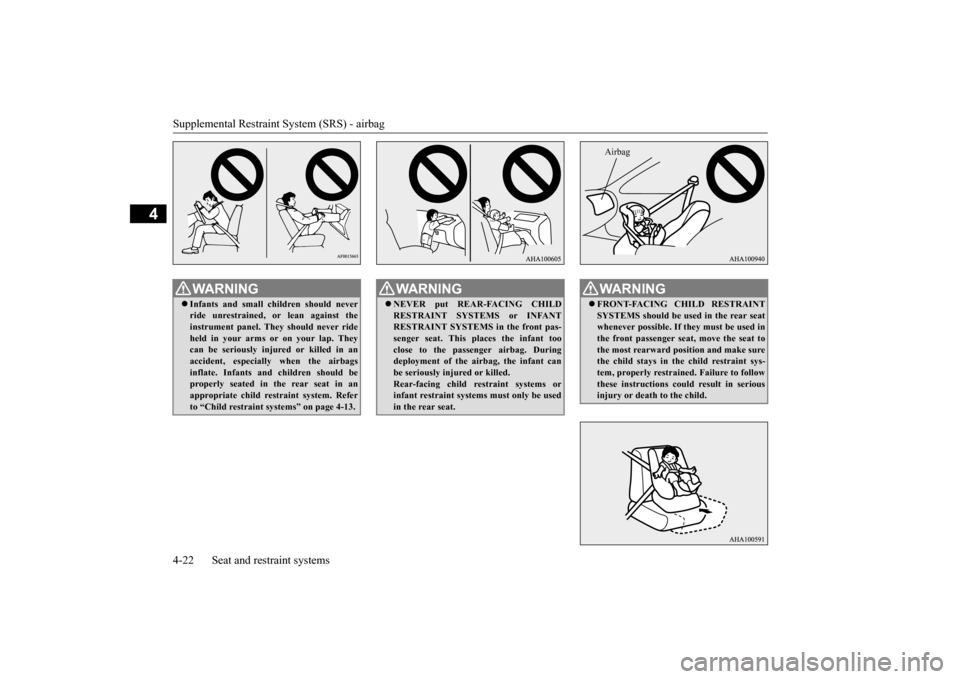
Supplemental Restraint System (SRS) - airbag4-22
Seat and restraint systems
4
W
AR
NING
Infants
and
small
children shoul
d never
ride
unr
estrained,
or
lean
against
the
instr
ume
nt panel.
The
y shoul
d never rid
e
held
in
your
arms
or
on
your
lap.
They
can
be seriously
injur
ed or
killed
in an
accid
ent, especially
whe
n the
airbags
inflate.
Infa
nts
and
children shoul
d be
properly
seated
in
the
rear
seat
in
an
appr
opriate
child
restraint
system.
Refer
to “Child
restraint
systems”
on
page
4-13.
W
AR
NING
NEVER
put
REAR-F
ACING
CHILD
RESTRAINT
SYSTEM
S or INF
ANT
RESTRAINT
SYSTEM
S in the
front
pas-
senger
seat.
Thi
s places
the
infant
too
close
to
the
passe
nger
airbag.
Durin
g
deployme
nt
of
the
airbag,
the
infant
can
be seriousl
y injur
ed or
killed
.
Rear-facing
child restraint
syste
ms
or
infant
restraint
systems
must
only
be
used
in the
rear seat.
W
AR
NING
FRONT-FACING
CHILD
RESTRAINT
SYSTEM
S shoul
d be use
d in the
rear seat
whe
never possi
ble. If the
y must
be use
d in
the front passenger
seat,
move
the seat
to
the
most
rearward
position
and
make
sur
e
the child stays
in the child restrain
t sys-
tem,
properly
restrained.
Failur
e to follow
these
instructions
could
result
in
serious
injur
y or
death to
the
child.
Airbag
Page 47 of 392
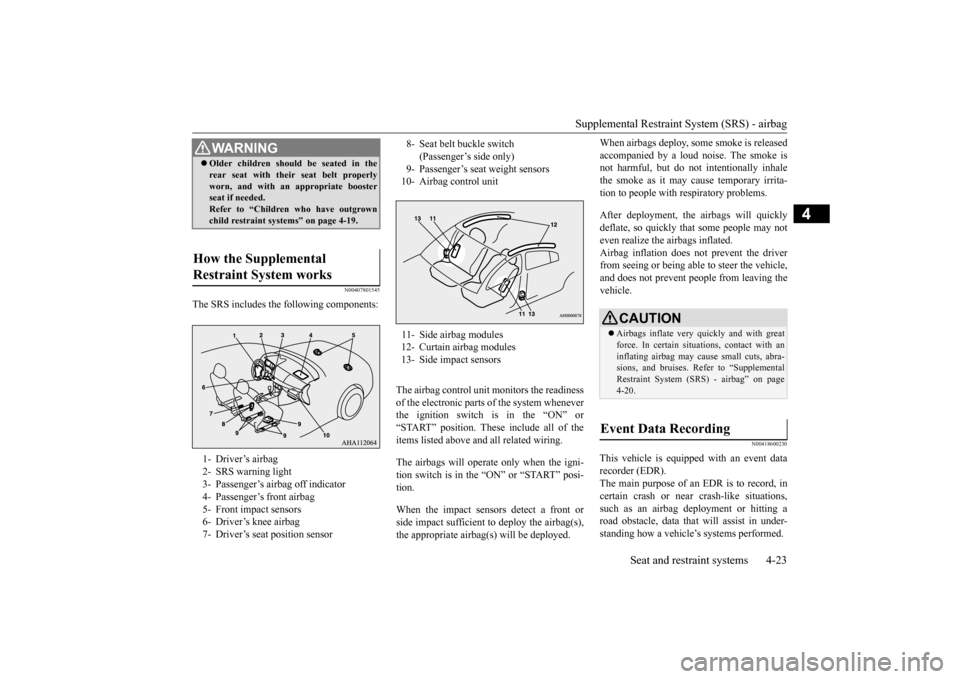
Supplemental Restraint System (SRS) - airbag
Seat and restraint systems
4-23
4
N00407801
545
The SRS includes the following components:
The
airbag
control
unit
monitors
the
readiness
of the
electronic
parts
of the
system
whenever
the
ignition
switch
is
in
the
“ON”
or
“ST
ART”
position.
These
include
all
of
the
items listed above and all related wiring. The
airbags
will
operate
only
when
the
igni-
tion
switch
is in the
“ON”
or
“ST
ART”
posi-
tion. When
the
impact
sensors
detect
a front
or
side
impact
suf
ficient
to deploy
the
airbag(s),
the appropriate airbag(s) will be deployed.
When
airbags
deploy
, some
smo
ke
is relea
sed
accompanied
by
a loud
noise.
The
smoke
is
not
harmful,
but
do
not
intentionally
inhale
the
smoke
as
it may
cause
temporary
irrita-
tion to people with respiratory problems.After
deployment,
the
airbags
will
quickly
deflate,
so
quickly
that
some
people
may
not
even
realize
the
airbags
inflated.
Airbag
inflation
does
not
prevent
the
driver
from
seeing
or being
able
to steer
the
vehicle,
and
does
not
prevent
people
from
leaving
the
veh
icle.
N00418600
230
This
vehicle
is equipped
with
an
event
data
recorder
(EDR).
The
main
purpos
e of
an
ED
R is to record,
in
certain
crash
or
near
crash-like
situations,
such
as
an
airbag
deployment
or
hitting
a
road
obstacle,
data
that
will
assist
in
under
-
standing how a vehicle’
s systems performed.
W
AR
NING
Older
childr
en
should
be
seated
in
the
rear
seat
with
their
seat
belt
properly
worn,
and
with
an
appr
opriate
booster
seat
if needed.
Refer
to
“Childr
en who
have
outgr
own
child
restraint
systems”
on
page
4-19.
How the Supplemental Restraint System works 1-
Driver
’s airbag
2-
SRS warning light
3-
Passenger
’s airbag of
f indicator
4-
Passenger
’s front airbag
5-
Front impact sensors
6-
Driver
’s knee
airbag
7-
Driver
’s seat
position
sensor
8-
Seat
belt
buckle
switch
(Passenger
’s side only)
9-
Passenger
’s seat weight sensors
10-
Airbag control unit
11-
Side airbag modules
12-
Curtain airbag modules
13-
Side impact sensors
CAUTIONAirba
gs
inflate
ver
y quick
ly and
with great
force.
In certain
situations,
con
tact
with an
inflating
airbag
may
cause
small
cuts, abra
-
sions, and
brui
ses. Ref
er to
“Supplemen
tal
Restraint
System
(SRS)
- airbag”
on
page
4-20.
Event Data Recording
Page 48 of 392
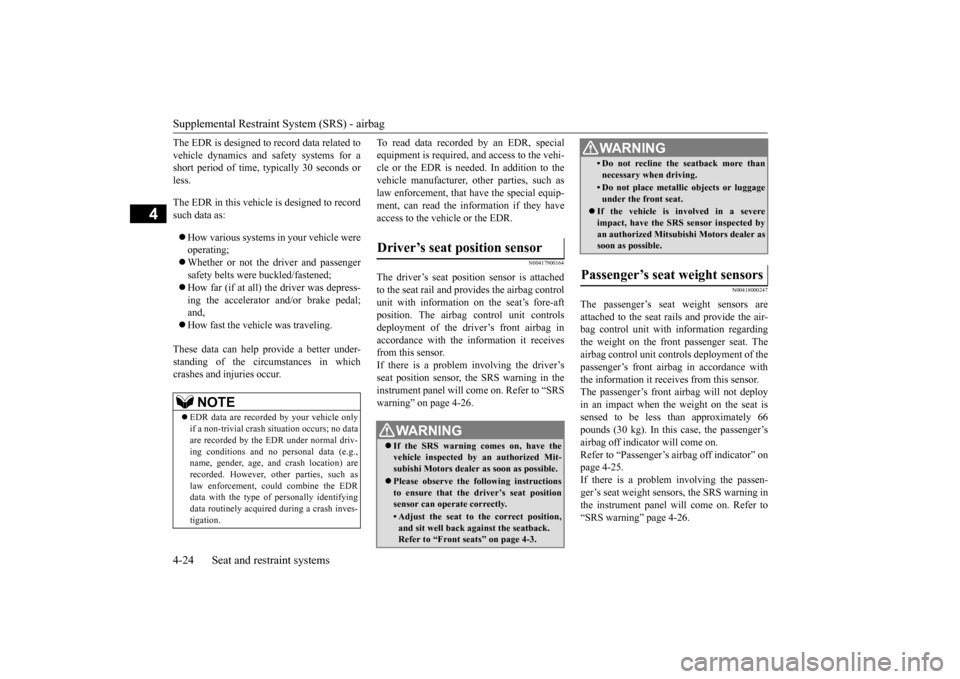
Supplemental Restraint System (SRS) - airbag4-24
Seat and restraint systems
4
The
EDR
is designed
to record
data
related
to
vehicle
dynamics
and
safety
systems
for
a
short
period
of
time,
typically
30
seconds
or
less.The
EDR
in this
vehicle
is designed
to record
such data as:How
various
systems
in your
vehicle
were
oper
atin
g;
Whether
or
not
the
driver
and
passenger
safety belts were buckled/fastened;How
far
(if
at all)
the
driver
was
depress-
ing
the
accelerator
and/or
brake
pedal;
and,How fast the vehicle was traveling.
These
data
can
help
provide
a better
under
-
standing
of
the
circumstances
in
which
crashes
and
injuries
occur
.
To read
data
recorded
by
an
EDR,
special
equipment
is required,
and
access
to the
vehi-
cle
or
the
EDR
is needed.
In
addition
to
the
vehicle
manufacture
r, other
parties,
such
as
law
enforcement,
that
have
the
special
equip-
ment,
can
read
the
information
if they
have
access to the vehicle or the EDR.
N0041790
0164
The
driver
’s seat
position
sensor
is attached
to the
seat
rail
and
provides
the
airbag
control
unit
with
information
on
the
seat’
s fore-aft
position.
The
airbag
control
unit
controls
deployment
of
the
driver
’s front
airbag
in
accordance
with
the
information
it receives
from this
sens
or.
If there
is a problem
involving
the
driver
’s
seat
position
sensor
, the
SRS
warning
in
the
instrument
panel
will
come
on.
Refer
to “SRS
warning” on page 4-26.
N0041800
0247
The
passenger
’s
seat
weight
sensors
are
attached
to the
seat
rails
and
provide
the
air-
bag
control
unit
with
information
regarding
the
weight
on
the
front
passenger
seat.
The
airbag
control
unit
controls
deployment
of the
passenger
’s front
airbag
in
accordance
with
the information it receives from this sensor
.
The
passenger
’s front
airbag
will
not
deploy
in
an
impact
when
the
weight
on
the
seat
is
sensed
to
be
less
than
approximately
66
pounds
(30
kg).
In
this
case,
the
passenger
’s
airbag of
f indicator will come on.
Refer to “Passenger
’s airbag of
f indicator” on
page 4-25. If
there
is
a problem
involving
the
passen-
ger
’s seat
weight
sensors,
the
SRS
warning
in
the
instrument
panel
will
come
on.
Refer
to
“SRS warning” page 4-26.
NOTE
EDR data
are
recorded
by
your
vehicle
only
if a non-trivial
cras
h situation
occurs
; no
data
are
recorded
by
the
EDR
under
normal
driv-
ing
conditions
and
no
personal
data
(e.g.,
name,
gende
r, age, and
crash
location)
are
recorded.
However
, other
parties,
such
as
law
enforcement,
could
combine
the
EDR
data
with
the
type
of personally
identifying
data
routinely
acquired
during
a crash
inves-
tigation.
Driver
’s seat position sensor
W
AR
NING
If the SRS
warn
ing comes
on, have
the
vehicle
inspect
ed by
an
authorized
Mit
-
subishi
Motors
dealer
as soon
as possible.
Please
observ
e the
followi
ng
instr
uctions
to
ensur
e that
the
driv
er’s seat
posi
tion
sensor
can
operate
correctly.
•Adjust
the
seat
to
the
correct posi
tion,
and
sit well
back
against
the seatb
ack
.
Refer
to “Fr
ont seats
” on page
4-3.
•Do
not
reclin
e the
seatbac
k mor
e than
necessar
y whe
n driv
ing.
•Do
not
place
metallic
objects
or
luggage
under
the front seat.
If
the
vehicle
is
involved
in
a sever
e
impact,
have
the
SRS
sensor
inspected
by
an
authorized
Mitsubi
shi
Motor
s dealer
as
soon
as possible.
Passenger
’s seat
weight
sensors
W
AR
NING
Page 49 of 392
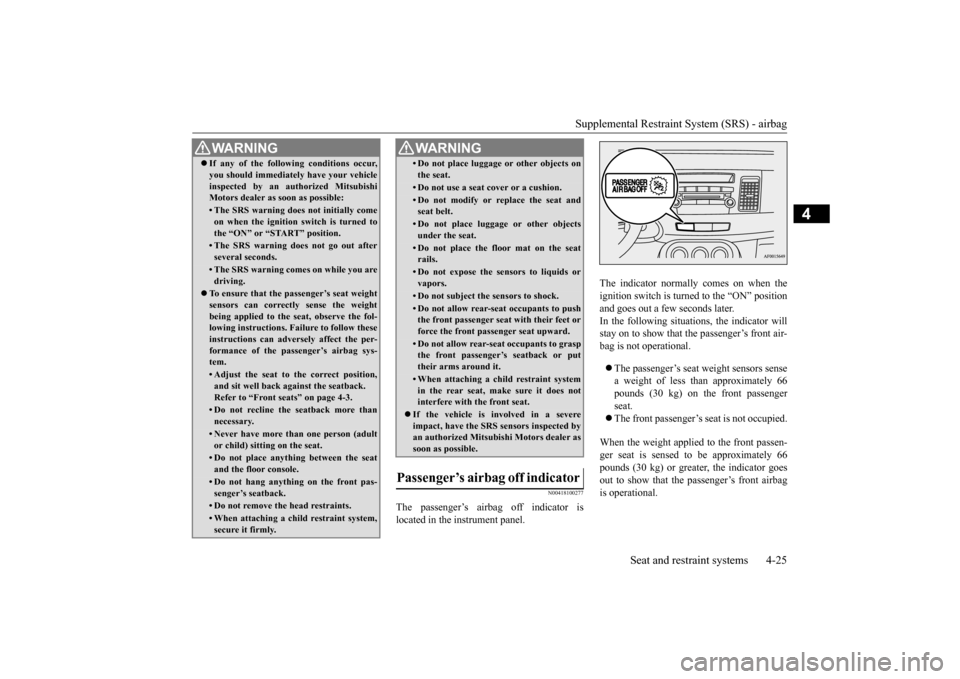
Supplemental Restraint System (SRS) - airbag
Seat and restraint systems
4-25
4
N00418100
277
The
passenger
’s
airbag
off
indicator
is
located in the instrument panel.
The
indicator
normally
comes
on
when
the
ignition
switch
is turned
to the
“ON”
position
and goes out a few seconds later
.
In
the
following
situations,
the
indicator
will
stay
on
to show
that
the
passenger
’s front
air-
bag is not operational.The
passenger
’s seat
weight
sensors
sense
a weight
of
less
than
approximately
66
pounds
(30
kg)
on
the
front
passenger
seat.The
front
passenger
’s seat
is not
occupied.
When
the
weight
applied
to the
front
passen-
ger
seat
is
sensed
to
be
approximately
66
pounds
(30
kg)
or
greater
, the
indicator
goes
out
to show
that
the
passenger
’s front
airbag
is operational.
W
AR
NING
If any
of
the
followi
ng
condi
tions
occu
r,
you
shoul
d imme
diately
have
your
vehicle
inspected
by an authorized
Mitsubi
shi
Motors
dealer
as soon
as possible:
•The SRS
warn
ing does
not
initially come
on
whe
n the
ign
ition
swi
tch is tur
ned to
the
“ON” or “ST
ART” posi
tion.
•The
SRS
warning
does
not
go
out
after
several
seconds.
•The SRS
warn
ing comes
on while
you
are
driv
ing.
To ensur
e that
the
passe
nge
r’s seat weight
sensors
can
corr
ectly
sense
the
weight
being
applied
to the
seat
, observe
the
fol-
lowing
ins
tructions.
Failur
e to follow
these
instr
uctions
can
advers
ely
affect
the
per-
for
mance
of
the
passe
nge
r’s airbag
sys-
tem.•Adjust
the
seat
to
the
correct posi
tion,
and
sit well
back
against
the seatb
ack
.
Refer
to “Fr
ont seats
” on page
4-3.
•Do
not
reclin
e the
seatbac
k mor
e than
necessary
.
•Never
have
mor
e than
one
person
(adult
or child)
sitting
on
the
seat.
•Do
not
place
anything
between
the
seat
and the floor console.•Do
not
hang
anything
on
the
front
pas-
sen
ger
’s seatback.
•Do not remove
the
head
restraints.
•When
attaching
a child
restraint
system,
secur
e it firmly
.
•Do not place
luggage
or
oth
er objects
on
the
seat.
•Do
not
use
a seat
cover
or a cushion.
•Do
not
modify
or
replace
the
seat
and
seat
belt.
•Do
not
place
luggage
or other
object
s
under
the
seat.
•Do not
place
the floo
r mat
on the
seat
rails
.
•Do
not
expose
the
sensors
to
liquids
or
vapors.•Do not subject
the sensors
to shock
.
•Do not allow
rear
-seat
occupa
nts to push
the
front
passenger
seat
with
their
feet
or
force the
front passe
nger s
eat upward
.
•Do not
allow
rear
-seat
occupants
to grasp
the
front
passe
nge
r’s seatbac
k or put
their
arms
around i
t.
•When attac
hing
a child restraint
syste
m
in
the
rear
seat, make
sure it does
not
interfer
e with
the front seat.
If
the
vehicle
is
involved
in
a sever
e
impac
t, have
the
SRS
sensor
s inspect
ed by
an authorized
Mitsubi
shi
Motor
s dealer
as
soon
as possi
ble.
Passenger
’s airbag
off
indicator
W
AR
NING
Page 50 of 392
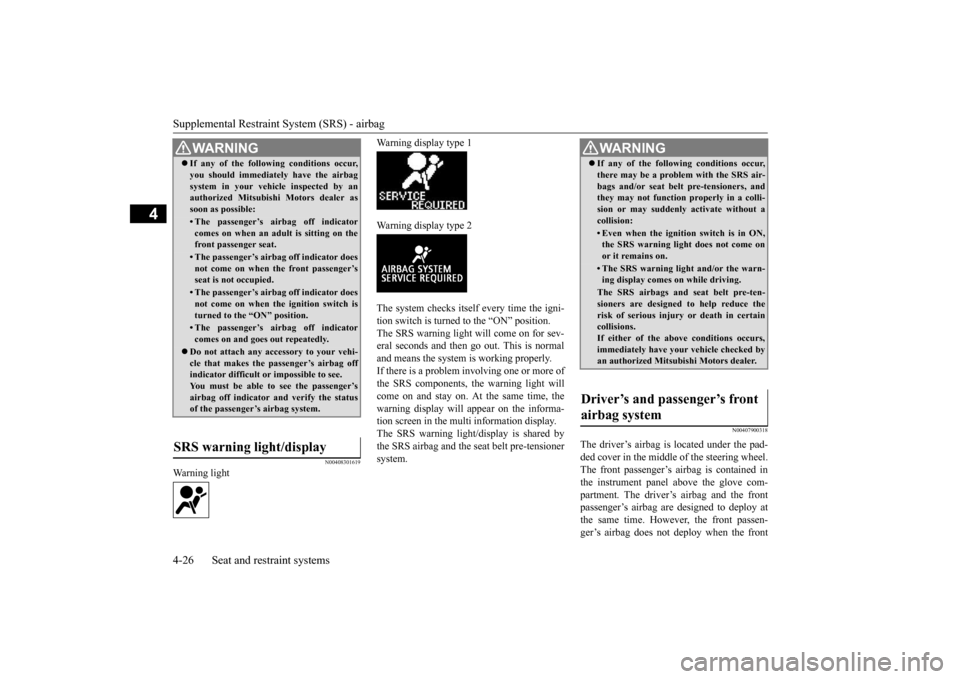
Supplemental Restraint System (SRS) - airbag4-26
Seat and restraint systems
4
N0040830
1619
Warning light
Warning display type 1Warning display type 2The
system
checks
itself
every
time
the
igni-
tion switch is turned to the “ON” position. The
SRS
warning
light
will
come
on
for
sev-
eral
seconds
and
then
go
out.
This
is normal
and means the system is working properly
.
If there
is a problem
involving
one
or more
of
the
SRS
components,
the
warning
light
will
come
on
and
stay
on.
At
the
same
time,
the
warning
display
will
appear
on
the
informa-
tion screen in the multi information display
.
The
SRS
warning
light/display
is shared
by
the
SRS
airbag
and
the
seat
belt
pre-tensioner
system.
N0040790
0318
The
driver
’s airbag
is located
under
the
pad-
ded
cover
in the
middle
of the
steering
wheel.
The
front
passenger
’s airbag
is contained
in
the
instrument
panel
above
the
glove
com-
partment.
The
driver
’s airbag
and
the
front
passenger
’s airbag
are
designed
to
deploy
at
the
same
time.
However
, the
front
passen-
ger
’s airbag
does
not
deploy
when
the
front
W
AR
NING
If any
of
the
followi
ng
condi
tions
occu
r,
you
shoul
d imme
diately
have
the
airbag
syste
m in your
vehicle
inspect
ed by
an
authorized
Mitsubi
shi
Motor
s dealer
as
soon
as possible:
•The
passenger
’s airbag
off
indicator
comes
on
when
an
adult
is sitting
on
the
front
passenger
seat.
•The
passenger
’s airbag
off
indicator
does
not
com
e on
whe
n the
front
passe
nge
r’s
seat is no
t occupied
.
•The
passenger
’s airbag
off
indicator
does
not
come
on
when
the
ignition
switch
is
tur
ned to the
“ON” position.
•The
passenger
’s airbag
off
indicator
comes
on
and
goes
out
repeatedly
.
Do
not
attach
any
accessory
to your
vehi-
cle
that
make
s the
passe
nge
r’s airbag
off
indicator
difficu
lt or
impossi
ble to see.
You must
be able
to
see
the
passe
nge
r’s
airbag
off
indicator
and
verify
the
status
of the
passe
nge
r’s airbag
syste
m.
SRS warning light/display
W
AR
NING
If any
of
the
followi
ng
condi
tions
occu
r,
there may
be a problem
with the SRS
air-
bags
and/or
seat
belt
pre-tension
ers
, and
they
may
not
function
properly
in a colli-
sion
or
may
suddenly
activate
without
a
collis
ion:
•Even whe
n the
igni
tion
swi
tch is in ON,
the
SRS
war
ning
light
doe
s not
come
on
or it remains
on.
•The SRS
war
ning
light
and/
or the
war
n-
ing display
comes
on while
drivin
g.
The SRS
airb
ags
and
seat
belt
pre-ten
-
sioners
are designe
d to
help
reduce
the
risk
of serious
injur
y or death
in certai
n
collisions.If either
of
the
above
conditions
occurs,
immediately
have
your
vehicle
checked
by
an
authorized
Mitsubishi
Motors
dealer
.
Driver
’s and passenge
r’s fr
ont
airbag system